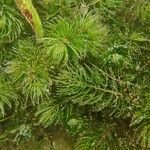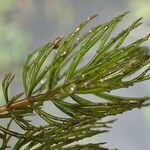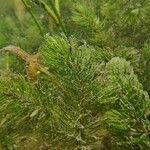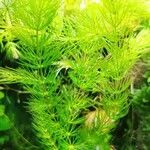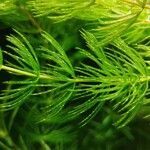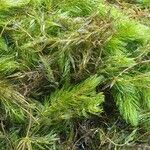Main stem to 2 m long. Leaves dichotomously branched 1 or 2 times, occasionally 3 times, to 4 cm long; segments usually coarse, with conspicuous spine-tipped teeth at least on apical segments; teeth with broad base of tissue. Male flowers often numerous, 1–3 per leaf whorl, to 3 mm diam.; perianth lobes to 1.3 mm long, with apical projection ± 0.2 mm long; anthers 0.5–1.5 mm long. Female flowers not as numerous as male flowers, 1 per leaf whorl; perianth lobes to 1.3 mm long, closely surrounding ovary, with apical projection 0.4–0.7 mm long; ovary to 1 mm long; style 1.5–5 mm long. Nut ovoid or ellipsoidal, slightly flattened but not winged (in Australian specimens), 4–6 mm long, 3–3.5 mm wide; surface smooth with sparse or numerous shiny gland dots; style 1.5–11 mm long; basal spines 1–7 mm long, slightly unequal in length.
Perennial, submerged hydrophyte, height depending on water depth, rootless, monoecious. Stem 1 branch per node. Leaves whorled, 6-8 per node, filiform, once or more dichotomously branched, 2 rows of minute teeth along ultimate segments, apical segments truncate, tipped with two spines. Flowers unisexual, solitary in axil of 1 leaf in a whorl, male and female on alternate nodes. Perianth: lobes 6-13, united at base, strap-shaped or obovate. Male flowers subsessile; stamens up to 30 in several whorls on receptacle around pistillode; anthers oblong, extrorse, 2-thecous, mature anthers detach, float to water surface, shedding pollen onto plants below. Female flowers ± sessile; ovary superior, ovoid, 1-locular, 1-carpellate; style long. Fruit a 1-seeded nut.
Stems to 3 m; apical leaf whorls densely crowded. Leaves bright green, coarse-textured. Leaf blade simple or forked into 2-4(-5) ultimate segments (forking of largest leaves 1st or 2d order, rarely 3d order), segments not inflated, mature leaf whorls 1.5-6 cm diam., marginal denticles conspicuous, usually strongly raised on broad base of green tissue; 1st leaves of plumule simple. Achene dark green or reddish brown, body (excluding spines) 3.5-6 × 2-4 × 1-2.5 mm, basal spines or tubercles 2 (rarely absent), straight or curved, 0.1-12 mm, spine bases occasionally inconspicuously webbed, marginal spines absent, terminal spine straight, 0.5-14 mm, margins wingless. 2 n = 24, 38, 40, 48.
Plant often much branched up to 3 m long, stems mostly red, internodes 1-3 cm. Leaves in whorls of 7-10, dark green when adult, 1-4 cm long, base gradually or abruptly thickened above the middle. Pedicel ¾-1½ mm. Perianth segments 9-12, linear, transparent greenish-white with numerous short brown lines, near the apex with few bristles, 1½-2 mm long. ♂: stamens 8 or more. ♀: ripe fruit black, 4-5 mm long, with 3 spines, apical spine (style) 11-12 mm long, soft, 2 basal ones straight (in Mal. material), patent to slightly recurved, 9-11 mm long.
A plant which grows in water and under the water. It forms tangled colonies. The stems are brittle and do not have roots. They are branched. They can be 2 m long. The leaves are 1.5-4 cm long and slender. They are dark green and forked. There are 7-12 leaves in a ring. The flowers are small and occur singly at the nodes. The flowers are of one sex. Male flowers have several stamens on a common stalk. Female flowers have an ovary without a stalk. The fruit are black and 4.5 mm long. There are 3 spines one at the end and 2 at the sides.
Stems to 3 m. Leaves bright green, coarse textured, 1--2 × dichotomously divided; whorls 1.5--6 cm in diam.; segments linear to filiform, 1.5--2 cm × 1--5 µm, not inflated. Flowers 1--3 mm in diam. Achene dark green to reddish brown, body (excluding spines) 3.5--6 × 2--4 mm, smooth or slightly tuberculate, margins wingless and spineless, facial spines absent; basal spines or tubercles 2, 0.1--12 mm, straight or curved; terminal spine (persistent style) 0.5--14 mm. Fl. and fr. Jun--Sep. 2n = 24, 38, 40, 48.
Stems elongate, freely branched, forming large masses; lvs in whorls of 5–12, rather stiff, variable, 1–3 cm, mostly once or twice forked, the ultimate segments linear, flat, 0.5 mm wide, but nearly doubled in width at the broad, antrorse teeth; achene ellipsoid, 4–6 mm, with 2 basal spines; first 2 pairs of plumular lvs unbranched; 2n=24. Abundant in quiet water; widespread from s. Can. to S. Amer., and widely distributed in the Old World.
Delicate submerged or floating aquatic herb; stems 30-150 cm long. Lvs whorled, dark green, stiff, 1-2× forked, 10-30 mm long; segments filiform to linear, denticulate, bristle-tipped. Nut black, 4-5 mm long; face smooth; basal spines 2, reflexed; terminal spine (style) 4-6 mm long.
Monoecious, submerged, aquatic perennial to 3 m. Leaves in whorls of 7-11, twice-forked, margins with small spines. Flowers 1-few in axils, green.
